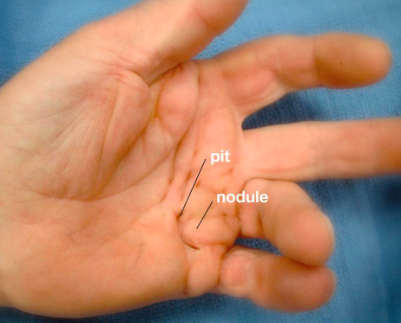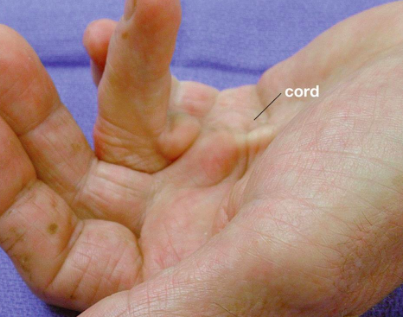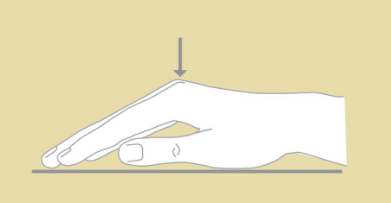Dupuytren's Contracture
Dupuytren’s contracture is an abnormal thickening of the tissue just beneath the skin. This thickening occurs in the palm and can extend into the fingers. Firm pits, bumps and cords (thick lines) can develop and cause the fingers to bend into the palm (Figures 1 and 2). This condition may also be known as Dupuytren’s Disease. Occasionally, the disease will cause thickening on top of the knuckles or cause lumps and cords on the soles of the feet (plantar fibromatosis).


Causes
The cause of Dupuytren’s contracture is unknown. The problem is more common in men, people over age 40 and people of northern European descent. There is no proven evidence that hand injuries or specific jobs lead to a higher risk of developing Dupuytren’s contracture.
Signs and Symptoms

Symptoms of Dupuytren’s contracture usually include lumps and pits within the palm. The lumps are generally firm and stuck to the skin. Thick cords may develop from the palm into one or more fingers. The ring and small fingers are most commonly involved. These cords may cause bending of the fingers. In many cases, both hands are affected, but each hand can be affected differently.
The lumps can be uncomfortable in some people, but Dupuytren’s contracture is not typically painful. The disease may first be noticed because of difficulty placing the hand flat on a surface (Figure 3). As the fingers are drawn into the palm, it may be more difficulty to wash hands, wear gloves, shake hands, and get hands into pockets. It is difficult to predict how the disease will progress. Some people have only small lumps or cords while others will develop severely bent fingers. The disease tends to be more severe if it occurs at an earlier age.
Treatment
In mild cases, especially if hand function is good, only observation is needed. A lump in the palm does not mean that treatment is required or that the disease will progress. For more severe cases, various treatment options are available to straighten the finger(s). These options may include needles, injectable medicine or surgery.
Your hand surgeon will discuss the most appropriate method based upon the stage and pattern of the disease and the joints involved. The goal of treatment is to improve finger motion and function; however, complete correction of the finger(s) may not always happen. Even with treatment, the disease may come back. Before treatment, the surgeon will discuss realistic goals and possible risks.
Splinting and hand therapy are often needed after treatment in order to maintain the improved finger function.
